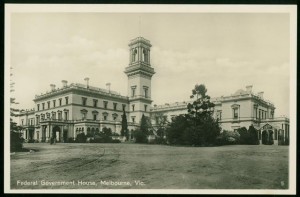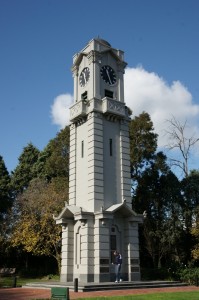Victoria’s Contribution to WWI
- Melbourne – the seat of Federal Government
- Broadmeadows military camp
- Work for women
- Children at war
- Counting the cost
- Peace
Melbourne – the seat of federal government
Since federation in 1901 when Australia became one nation, Melbourne had been the federal capital city. The most populous, the grandest, the most dignified of the colonial capitals and now the national capital, Victorians took pride in the status of their capital city.
War would focus even greater attention on Melbourne: Federal Parliament sat there, the Governor-General and the Prime Minister resided there. The major government departments, most importantly the Department of Defence, were all in Melbourne and the headquarters of the military was Victoria Barracks on St Kilda Road.
With suggestions that war might break out in Europe, crowds of Melburnians surged around the newspaper offices in Collins Street waiting from some sort of announcement. The newspapers posted the latest cable news on boards on the walls of their buildings. The excitement was extraordinary, the passion intense. Melbourne had never been gripped by anything like it.
Broadmeadows military camp

Recruits arriving at Broadmeadows Military Camp in 1914. Pictures Collection, State Library of Victoria.
Alongside other Australians, Victorians rushed to enlist when recruiting commenced. The first recruits camped in tents in the courtyard of the Victoria Barracks while others were put up at the Showgrounds or at racecourses. A patriotic Victorian, R.G. Wilson, offered to house a military camp on his land at Broadmeadows and the government quickly accepted. (Later the government bought the land). Broadmeadows camp was close to a railway line, was flat and could be well-watered. There was plenty of room for a large number of soldiers.
On 19 August 1914, two weeks and one day after the announcement of war, 2,500 men set off for Broadmeadows from central Melbourne. Crowds lined the streets as these men in mufti, some clutching Gladstone bags and some carrying neat parcels, walked from Victoria Barracks to the camp.
Leaving the Barracks at 9.30am they reached the camp at 5pm where they found ‘a green plain, rather high and windswept, with rows of pine trees and an old homestead.’ ‘A hard road made [for] many sore feet,’ a marcher reported.
Work for women
The Governor-General’s wife, Lady Helen Munro-Ferguson, called on Australian women to form themselves into branches of the British Red Cross Society and Victorian women responded with great eagerness. Soon Victoria had the greatest number of Red Cross branches and the greatest number of members.
Women raised money, prepared medical supplies and clothing for the soldiers, and also put together thousands of parcels of small luxuries such as soap, tobacco and fruit cakes, which were known collectively as ‘comforts’ throughout the war years.
So huge was the enterprise these women created and managed that the Governor-General for the rest of the war surrendered his grand ballroom, his sitting-room and occasionally his dining room to accommodate the range and amount of goods that were flowing in. This work continued throughout all the years of war.
Children at war
Children, too, were recruited for the war effort and they contributed eagerly. In early 1917 the Victorian Education Department published a booklet telling how magnificently Victorian schoolchildren had performed. The title says it all: How We Raised the First Hundred Thousand: an account of two years’ war work (1915-1916) for the Education Department’s War Relief Fund. One hundred thousand pounds, that is. A note at the back of the booklet brings the figure up to date, to 31 December 1916: a total of £149 000 and 350 000 ‘comfort items’ made or given in, and sent to soldiers abroad.
How did the children raise so much money? Country children ‘gathered bones, fat, bottles, wool from the fences and scrub, iron and kerosene tins; they snared and skinned rabbits, trapped foxes, caught fish, dug gardens, cleared tracks . . . ‘ City children ‘have sewn and knitted, made paper and leather flowers, fashioned things of wool and wire, grown wonderful beans on pocket-handkerchief allotments, planned concerts and bazaars.’ Across the war years Victorian children amassed an astonishing £422,470; truly patriotic efforts had become a part of the Victorian school curriculum.
Counting the cost
Every Victorian, man , woman or child knew someone at the war. A brother or son, a husband, a work colleague, a boy from just down the street, and there was anxiety and concern for each one of them. Casualty lists were regularly published in the newspapers and were also displayed in churches or left hanging from the gates of railway stations. The war was everywhere. Increasingly, bereaved women, mothers, wives and sisters, would be seen on the city streets, at church, on the trains and trams, in ‘mourning black’, long black dresses, shawls and capes, letting everyone know of their loss.
Soon, too, badly wounded men began to return from the front on hospital ships. They would be paraded in cars through the city streets to the admiration and concern of large crowds of well-wishers watching the parade and cheering the soldiers on, hopefully to good health. A mighty military hospital was opened at Caulfield. The Red Cross women from Birchip in the Wimmera raised £2,000 to equip just one operating theatre at the hospital as an example of their involvement and concern. Such dedication was common across the state.
Peace
When peace came there was a service of remembrance in Melbourne for the fighting men of Australia who had died in the war. Held in front of federal Parliament House in Spring Street on the first Sunday of peace, it attracted a massive crowd.
A special reserve had been set aside for the relatives of the fallen. A reporter, leaving the service, heard a woman remark, ‘I have lost seven nephews. Life can never be the same to me again, but, oh!, I feel so proud.’









